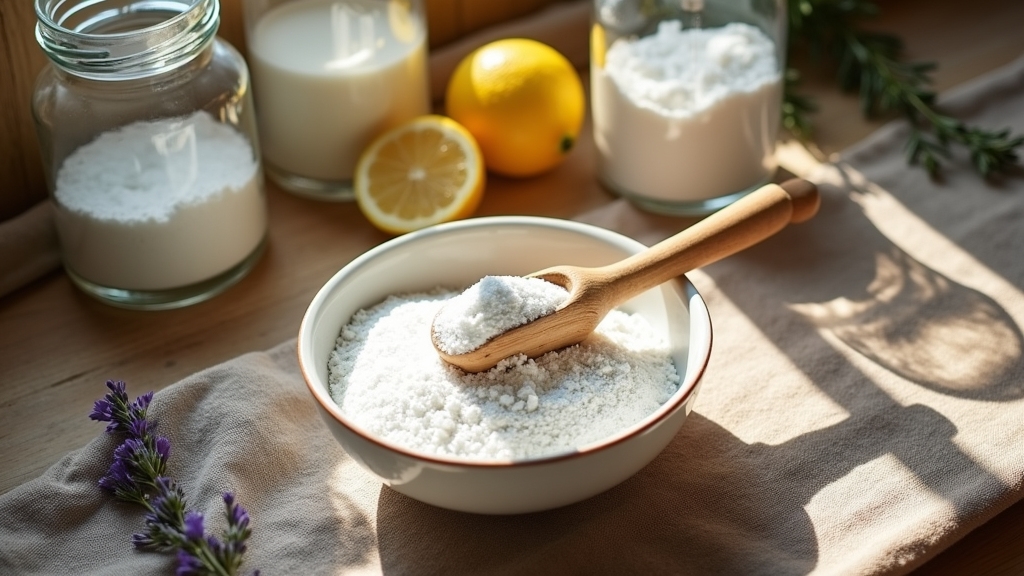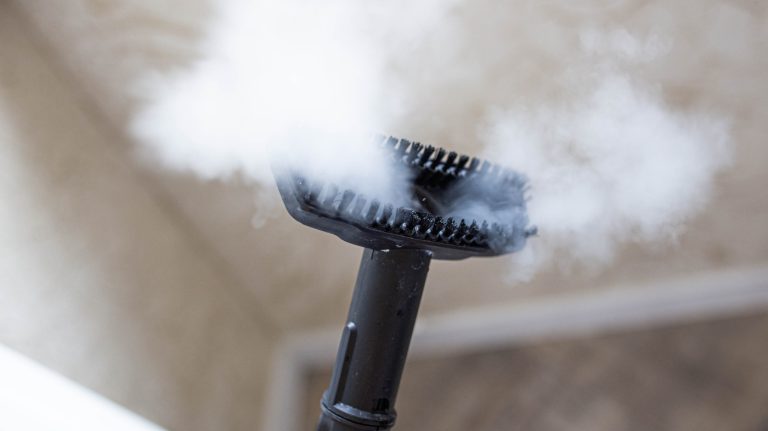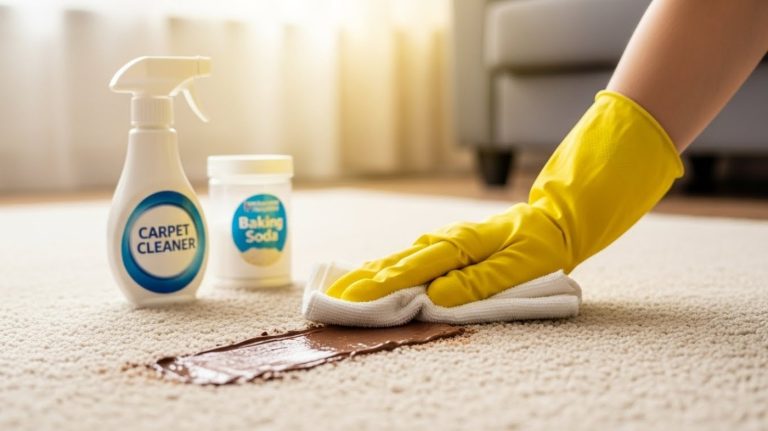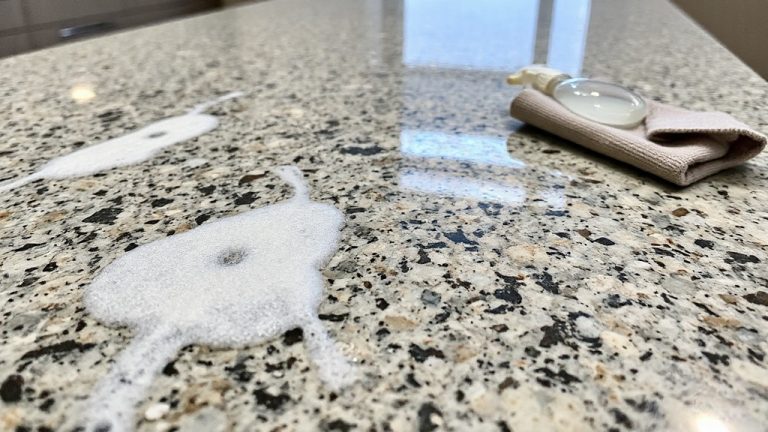Homemade Washing Powder Recipe: Step-by-Step DIY Guide
You can make effective homemade washing powder by mixing equal parts washing soda, borax, and baking soda with grated bar soap and a bit of salt for water softening.
Measure carefully—about 1.5 to 2 tablespoons per load—and store the powder airtight to prevent clumping.
Use warm water cycles for best results, and pre-treat stains with a soap paste when needed.
This DIY option is economical, eco-friendly, and customizable; continuing will reveal more preparation tips and safety guidelines.
Key Takeaways
- Combine equal parts washing soda, baking soda, and grated soap flakes for the base of homemade washing powder.
- Add salt and optional borax or oxygen bleach to enhance cleaning and stain removal.
- Mix dry ingredients thoroughly, store in airtight containers away from moisture and sunlight.
- Use about 1.5 to 2 tablespoons per regular washing load, adjusting for soil level and water hardness.
- Pre-treat stains with a paste of washing soda or baking soda before laundering for better results.
Essential DIY Ingredients and Steps for Homemade Washing Powder
| Ingredient / Tool | Purpose / Action |
|---|---|
| Washing Soda (Sodium Carbonate) | Softens water, raises pH, boosts cleaning power |
| Baking Soda (Sodium Bicarbonate) | Mild abrasive, deodorizer, enhances detergent action |
| Grated Bar Soap | Primary surfactant; emulsifies oils and lifts dirt |
| Borax (Optional) | Improves stain removal, offers antimicrobial properties |
| Salt | Prevents clumping, softens water, enhances powder texture |
| Oxygen Bleach (Optional) | Whitens fabrics, removes tough stains naturally |
| Essential Oils (Optional) | Adds fragrance, antimicrobial benefit |
| 5-Gallon Bucket with Lid | Large batch mixing and storage |
| Long-handled Spoon / Spatula / Whisk | Ensures thorough mixing, prevents clumping |
| Kitchen Scale | Accurate measurement of ingredients |
| Fine-hole Grater / Food Processor | Shreds soap into fine, uniform pieces |
| Airtight Containers | Keeps powder dry and preserves effectiveness |
| Gloves & Mask | Protects skin and lungs during handling |
Essential Ingredients for Effective Cleaning
When you make homemade washing powder, choosing the right ingredients is essential for effective cleaning.
Washing soda (sodium carbonate) acts as a powerful builder by softening water and boosting pH, which enhances grime removal.
Washing soda softens water and raises pH, boosting cleaning power and grime removal effectiveness.
Baking soda (sodium bicarbonate) serves as a mild abrasive and deodorizer, improving detergent action and water softening.
Soap powder or grated bar soap provides the primary surfactant action to emulsify oils and suspend soils. For best results in HE washers, grating small soap pieces helps it dissolve better and prevents residue buildup, especially when using warm water.
Salt aids in stain removal, water softening, and prevents clumping, improving powder texture.
Borax is optional but can enhance cleaning efficiency and offers antimicrobial properties.
Oxygen-based bleaches like OxiClean add stain removal and brightening without harsh chemicals. Regular cleaning with the right ingredients also helps prevent residue build-up.
Tools Needed for Preparation
Selecting the right tools streamlines the process of making homemade washing powder and guarantees accuracy in ingredient measurement and mixing.
Use a 5-gallon bucket with a lid for large batch mixing and storage, marking the 5-gallon line for volume accuracy. Long-handled spoons or spatulas and whisks ensure thorough mixing and clump removal. Using an immersion blender on concentrated batches can improve consistency in texture. Ergonomic handles on mixing tools can reduce fatigue during prolonged preparation.
Employ kitchen scales for precise weight measurements and a fine-hole grater or food processor to shred soap finely. Use airtight, durable containers like Rubbermaid or glass jars with pop-off lids for moisture-free storage.
Safety requires gloves and masks when handling powders, plus permanent markers for labeling batches. Clean surfaces and utensils with dish soap and cloths after preparation.
Funnels or scoops assist in transferring powders cleanly, maintaining an organized and efficient workflow. Selecting tools with multi-purpose use can simplify both preparation and cleanup tasks.
Step-by-Step Preparation Process
Although preparing homemade washing powder involves multiple steps, following a clear sequence guarantees consistency and effectiveness.
First, cut soap bars into 1-inch cubes and grate them using a food processor for a fine, cheese-like texture. Optionally, process grated soap with washing soda or borax for uniform powder. It is important to handle ingredients like borax with care, as safety considerations are debated but it is generally deemed acceptable by some sources. Proper storage in an airtight container also prevents moisture absorption that can degrade powder quality.
Next, measure equal parts washing soda, borax, and baking soda—typically 3-4 cups each—adding fine salt and optional additives like OxiClean or essential oils.
Thoroughly combine dry ingredients in a large container or sealable bag, shaking and kneading to eliminate lumps.
Finally, transfer the blended powder to an airtight container immediately to prevent moisture exposure, ensuring longevity and consistent detergent performance during use.
Tips for Proper Storage
Proper storage plays a vital role in maintaining the quality and effectiveness of your homemade washing powder after preparation.
Proper storage ensures your homemade washing powder remains effective and maintains its quality over time.
Use airtight containers, such as glass jars or secure plastic canisters, to prevent moisture absorption and ingredient clumping. Label each container clearly with contents and preparation date. Storing powders in well-ventilated areas can help minimize the risk of oxidation effects.
Store the powder in a cool, dry place, away from sinks, washing machines, and direct sunlight. Adding silica gel packets can help absorb residual moisture.
Avoid containers with damaged seals and keep them off the floor to reduce pest and dampness risks. Monitor regularly for clumping or discoloration, signs of spoilage.
Store in smaller batches to minimize air exposure from frequent opening. Organize containers at waist or eye level for easy access and rotate stock using the first-in, first-out method to guarantee freshness and safety.
How to Use Homemade Washing Powder?
When it comes to using your homemade washing powder, you’ll want to start by measuring out about 1.5 to 2 tablespoons for a regular load. Of course, feel free to adjust that amount based on the size of your load or how soiled your clothes are. It’s all about making sure everything gets cleaned properly!
Now, a little tip: pour the powder directly onto the clothes inside the washer drum, especially if you’re using a high-efficiency (HE) machine. This helps the powder dissolve better and prevents any clogs in the dispenser. This recipe is designed specifically for HE washers, ensuring low or no suds for effective rinsing.
If you’ve got some tough stains to tackle, don’t worry! You can pre-treat those garments or even add some boosting agents to your wash for better results. Always remember to follow safety guidelines when handling cleaning agents to avoid any hazards. Happy washing!
Dosage Recommendations
When using homemade washing powder, start with 1 to 2 tablespoons per regular load to guarantee effective cleaning without leaving residue. For large or heavily soiled loads, increase dosage to 2 to 2.5 tablespoons. Use 1 to 1.5 tablespoons for small or lightly soiled loads to prevent buildup.
Sprinkle the powder directly over clothes in the drum to ensure full dissolution, especially in HE machines. It is important to maintain the 3:3:5 ratio of borax, soap, and wash soda to ensure detergent effectiveness. If whitening white laundry, add 1 tablespoon of sodium percarbonate alongside the base dosage.
Use warm water above 40°C for activation. Avoid overdosing to prevent residue on fabrics and machines, as residue buildup can affect washing performance and fabric quality. Adjust dosage based on load size, soil level, and water temperature for suitable results. Consistently measure powder finely grated and mix well before use for even distribution and performance.
Machine Compatibility
Following dosage guidelines guarantees ideal cleaning and prevents residue, but compatibility with your washing machine type markedly impacts performance. Verify your machine’s manual for powder detergent guidelines.
High-efficiency (HE) washers need low-sudsing powders to avoid buildup, and powders may not dissolve fully in automatic dispensers. Front-loading machines are sensitive to undissolved powder; applying directly to clothes enhances effectiveness.
Using simple, chemical-free ingredients like washing soda and baking soda helps prevent chemical residue on clothing, protecting skin health.
To optimize use:
- Avoid automatic dispensers for homemade powder in HE machines; sprinkle powder directly on clothes.
- Use deep fill or soak cycles to improve dissolution.
- Pre-dissolve powder in warm water for cold washes.
- Balance powder formulation with mild, low-sudsing soaps and appropriate amounts of washing soda and borax for machine safety.
This approach ensures efficient cleaning and preserves machine integrity by reducing the risk of buildup that can harbor bacteria and odors.
Stain Treatment Tips
Although homemade washing powders excel at general cleaning, their stain removal effectiveness depends on prompt and targeted pre-treatment.
You should treat fresh stains immediately by applying a paste made from washing soda or baking soda mixed with water directly onto the stain.
Incorporate natural liquid castile soap or grated laundry soap as a rub to break down oils and dirt.
Let the paste sit for 15 to 30 minutes before laundering. Homemade detergents reduce exposure to harsh chemicals found in commercial detergents, making them a safer choice for sensitive skin.
Use about 1/2 cup of powder per load, increasing concentration on problem areas. It is important to avoid over-saturating fabrics to prevent damage during cleaning.
Avoid relying solely on homemade powders for tough dyes or inks, which require enzymatic cleaners.
Employ warm water cycles and consider pre-soaking stained items in soda solutions to enhance results.
Adjusting Dosage for Different Loads
When you’re dealing with small loads, it’s best to start with just 1 to 2 tablespoons of your homemade powder. This helps prevent any pesky residue buildup, which can be especially important for maintaining surface durability.
If you’ve got heavily soiled items, you might want to bump that up to 100ml. For water that is hard, increasing the detergent amount by about 30-40% can help improve cleaning effectiveness (water hardness adjustment).
And hey, don’t forget about the option of a pre-wash cycle—it can really boost your cleaning power!
Now, if you’re using a high-efficiency (HE) machine, you’ll want to dial that powder back a bit.
Generally, around 1 tablespoon per load should do the trick. This way, you can avoid oversudsing and keep your machine running smoothly.
Small Load Measurements
How much washing powder do you really need for a small load? Typically, using about 1.5 tablespoons is effective, but you might reduce this to 1 tablespoon or less to prevent residue and over-sudsing. It is important to avoid mixing bleach or other harsh chemicals with your detergent to prevent dangerous chemical reactions.
Tailor the dosage to your machine type, fabric, and water hardness for best results.
- Start with 1.5 tablespoons for small loads; reduce if washing results or suds are excessive.
- Use a fine, uniform powder to ensure complete dissolution in smaller water volumes. Homemade powders made with grated Feld Napa soap tend to dissolve well when prepared correctly.
- For top-loaders, 1 tablespoon often suffices; front-loaders may require even less detergent.
- Store powder in airtight containers and portion into small containers near the washer for convenience and accurate dosing.
Heavy Soil Considerations
Adjusting washing powder dosage for heavily soiled laundry guarantees thorough cleaning without wasting detergent or causing residue buildup.
For heavy loads, increase your standard 1–2 tablespoon dosage by 50–100%, starting with the base amount and adding more if needed.
Use a higher ratio of washing soda for grease-cutting and borax or sodium percarbonate for enhanced stain removal. Washing soda is essential in homemade recipes as it enhances cleaning power and helps with hard water deposits, making it particularly effective in tough soil situations washing soda benefits.
Grated soap quantity can also be increased to boost surfactant action.
Thoroughly mix powdered ingredients to avoid clumping, which impairs cleaning efficiency.
Store your powder airtight to prevent moisture absorption.
Test incremental dosage increases to prevent soap residue, especially in hard water areas.
For stubborn stains, consider pre-soaking or a second wash cycle rather than excessive detergent use.
Adjust dosage based on fabric type and visible soil for ideal results.
HE Machine Recommendations
Although HE washers use less water, they demand detergents formulated specifically for low-water conditions, usually marked with an “HE” logo.
Adjusting detergent dosage is vital for maximum cleaning and machine longevity. Use about 2 tablespoons (1 oz) for a regular load but scale accordingly for load size and water hardness. It is essential to use only HE-compatible detergents to prevent excess suds and potential machine damage.
Overdosing causes residue and potential damage; underdosing reduces cleaning effectiveness. Follow these guidelines:
- Use half the standard detergent for small loads (<6 lbs).
- Apply the standard dosage for medium loads (~6 lbs).
- Slightly increase detergent for large loads (~11 lbs), never doubling it.
- Adjust dosage upward in hard water areas or when using less concentrated detergents.
Enhancing Cleaning Power Naturally
When you incorporate plant-based surfactants and enzymes into your homemade washing powder, you considerably boost its ability to tackle stubborn stains like oils, food, and grass.
Surfactants from coconut or sugar sources surround and lift dirt, while enzymes like proteases and lipases break down organic stains efficiently. Adding oxygen-based bleach whitens fabrics without chlorine damage. Natural detergents are also generally biodegradable and low-toxicity, which helps protect waterways and aquatic life.
You can also include natural water softeners such as citric acid and baking soda, which enhance cleaning in hard water conditions. Essential oils provide natural fragrance and antimicrobial benefits, reducing skin irritation risks.
| Component | Function | Source Examples |
|---|---|---|
| Surfactants | Lift and remove dirt | Coconut, palm, sugar |
| Enzymes | Break down organic stains | Protease, lipase, amylase |
| Oxygen Bleach | Whitens fabrics | Sodium percarbonate |
| Water Softeners | Reduce mineral buildup | Citric acid, baking soda |
| Essential Oils | Add fragrance and antimicrobial | Lavender, citrus, sage |
Comparing Homemade and Commercial Detergents
Building on the natural components that enhance homemade washing powders, it’s important to evaluate how these formulations measure up against commercial detergents.
You’ll find commercial detergents excel in chemical complexity, stain removal, and fabric care, while homemade powders often lack enzymes and surfactants, reducing efficacy.
Consider these points:
- Commercial detergents use precise chemical balances to prevent fabric damage and residue; homemade mixes vary in pH and consistency.
- Commercial products function effectively across water temperatures, whereas homemade powders often require warm water. Many commercial detergents include cold water enzymes that boost cleaning power without extra energy.
- Environmental impact varies; some commercial options reduce packaging waste and energy use, but homemade powders may contain harmful ingredients like borax.
- Fabric longevity is generally better with commercial detergents, which protect colors and fibers more effectively than homemade soaps.
Cost Benefits of DIY Washing Powder
The cost benefits of making your own washing powder are compelling, especially when you consider the price per load compared to commercial detergents.
Homemade washing powder can cost as little as $0.03 to $0.04 per load, while commercial powders like Tide average around $0.12 per load.
Bulk purchasing ingredients such as washing soda, borax, and grated soap reduces costs further, allowing over 500 loads from $20 of materials.
This leads to annual savings between $150 and $500 depending on laundry frequency and detergent choice.
However, you should factor in time spent preparing the powder and potential variations in detergent effectiveness, which may influence overall cost efficiency. Additionally, the total cost depends on ingredient prices and quantities, with some items like borax potentially being more expensive, impacting the final cost considerations on cost.
Safety and Environmental Considerations
When you’re working with ingredients like borax or lye, it’s super important to wear gloves and masks. This helps to keep your skin and lungs safe from irritation. Improper handling of these substances can lead to chemical burns and serious health complications.
Plus, if you opt for natural, phosphate-free components, you’re doing your part to reduce environmental harm. Just keep in mind that even with those choices, if the formulations aren’t quite right, they can still pose some ecological risks.
Oh, and here’s a little heads-up: homemade powders can sometimes trigger allergic reactions or make your skin sensitive. So, it’s a good idea to test them out carefully before you start using them regularly. Better safe than sorry, right?
Handling Ingredients Safely
Although homemade washing powders offer a cost-effective cleaning alternative, you must handle ingredients like borax, lye, and essential oils with strict safety measures to prevent irritation, chemical burns, or toxic exposure. Always wear gloves, masks, and eye protection when mixing powders to minimize skin and respiratory contact.
Store all powders in airtight, clearly labeled containers, out of reach of children and pets. Avoid mixing incompatible chemicals such as bleach and vinegar to prevent hazardous gas release. It is important to note that some natural ingredients, such as borax, can cause skin irritation and other health issues if not handled properly.
Key safety practices include:
- Use dedicated, non-food utensils and containers to prevent contamination.
- Dispose of unused or expired ingredients per local hazardous waste regulations.
- Control essential oil concentrations to reduce allergic risks.
- Immediately seek medical aid if accidental ingestion occurs.
Environmental Impact Benefits
Ensuring safe handling of homemade washing powder ingredients naturally leads to contemplating their broader environmental effects.
By excluding phosphates and synthetic surfactants, you reduce water pollution, limiting eutrophication and toxicity in aquatic ecosystems.
The use of biodegradable components like washing soda and soap flakes guarantees rapid breakdown in wastewater treatment, minimizing persistent chemical residues.
Moreover, homemade powders eliminate artificial dyes and fragrances, decreasing pollutant discharge into waterways. Proper detergent usage and concentrated formulas also minimize chemical release and environmental harm.
You also cut plastic waste considerably by reusing containers and sourcing unpackaged, local raw materials, which lowers landfill burden and microplastic pollution.
Additionally, the reduced industrial processing of ingredients and cold-water washing decrease energy consumption and carbon emissions. This practice supports resource depletion reduction and lowers greenhouse gas emissions.
Allergy and Sensitivity Awareness
How can you effectively identify and manage allergies or sensitivities related to homemade washing powders?
Begin by conducting a patch test. Dilute the detergent 1:1 with water and apply it to your inner arm. Monitor for 24–48 hours for reactions like redness or itching. If symptoms appear, stop use immediately and consult a dermatologist. Using hypo-allergenic products can reduce irritation and flare-ups for sensitive skin conditions.
To minimize risks, follow these guidelines:
- Choose hypoallergenic, fragrance- and dye-free ingredients, such as vegetable oil-based soaps.
- Use minimal detergent amounts and run a double rinse cycle to reduce residue.
- Avoid fabric softeners and wear gloves when handling detergents to prevent direct skin contact.
- Always patch test new batches due to variable individual sensitivities and ingredient risks.
Frequently Asked Questions
Can Homemade Washing Powder Cause Skin Irritation or Allergies?
Yes, homemade washing powder can cause skin irritation or allergies. You might experience itching, redness, or dryness because alkaline substances and surfactants disrupt your skin’s pH and barrier.
If you add fragrances or essential oils, these can trigger allergic reactions. Sensitive skin or existing dermatitis increases your risk.
Residues on clothing may worsen symptoms. To minimize issues, use hypoallergenic ingredients and patch test any new formula before regular use.
How Long Does Homemade Washing Powder Last Before Losing Effectiveness?
You can expect homemade washing powder to remain effective for about 6 to 12 months when stored properly. Its natural ingredients degrade faster than commercial detergents, especially without preservatives.
Moisture and air exposure accelerate loss of cleaning power. To maintain efficacy, store your powder in airtight containers, keep it cool and dry, and avoid temperature fluctuations.
After 12 months, you might notice reduced cleaning ability, clumping, or altered scent, signaling it’s time to replace it.
Is Homemade Washing Powder Safe for All Fabric Types?
No, homemade washing powder isn’t safe for all fabric types. You should avoid using it on delicate materials like wool and silk since alkaline ingredients can cause shrinking, felting, or color fading.
Synthetic fabrics might retain residue, affecting texture.
Cotton and linen risk buildup over time.
Always test on a small area first, and consider using commercial detergents for sensitive or specialty fabrics to guarantee proper care and fabric longevity.
Can I Use Homemade Washing Powder in Cold Water Cycles?
Yes, you can use homemade washing powder in cold water cycles, but you need to guarantee it dissolves properly to avoid residue.
Adding the powder directly to the wash drum and using an extra rinse helps reduce undissolved particles. Pre-dissolving the powder in warm water also improves solubility.
Keep your powder dry during storage to prevent clumping, and adjust detergent amounts based on your washer type for maximum cleaning performance in cold water.
How Do I Dispose of Leftover Homemade Washing Powder Safely?
Think of leftover washing powder like leftover paint. Pouring it down the drain can stain the environment.
To dispose safely, avoid drains and toilets to prevent water contamination. Instead, use it up fully or donate it.
If it contains harsh chemicals, take it to a hazardous waste facility. Always rinse and recycle containers per local rules.
Handling leftovers responsibly keeps ecosystems safe and avoids costly pollution cleanup.
Boost Your Laundry Routine with Homemade Washing Powder
By making your own washing powder, you not only save money but also reduce environmental impact. Did you know commercial detergents contribute up to 70% of household plastic waste?
With simple ingredients and precise preparation, you can achieve effective cleaning while avoiding harsh chemicals. Proper storage guarantees your powder stays potent, and natural boosters enhance performance.
This DIY approach offers a sustainable, cost-efficient alternative without compromising cleaning power or safety.







